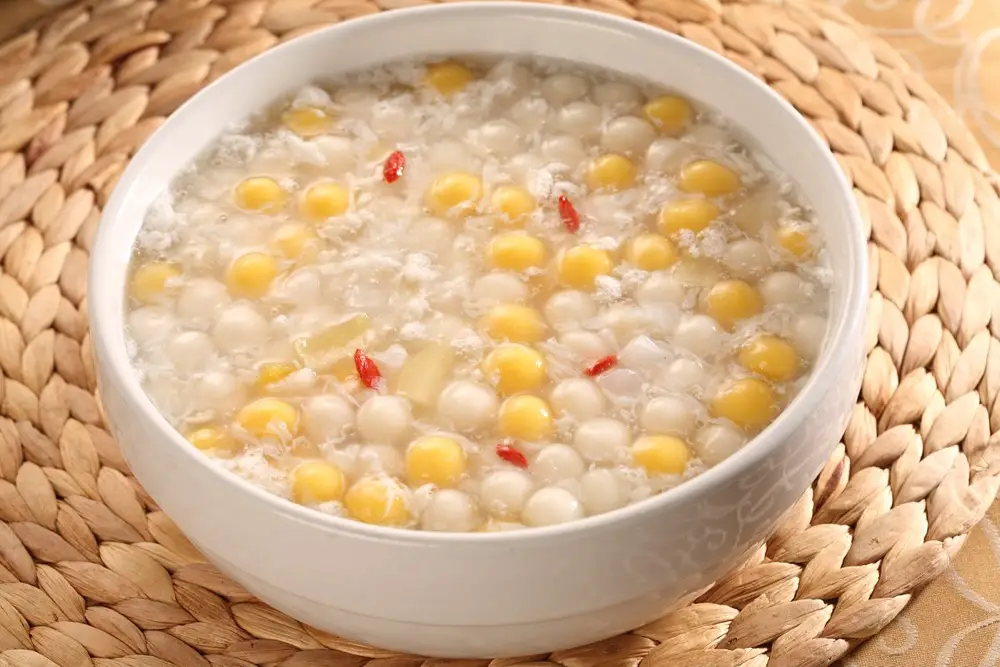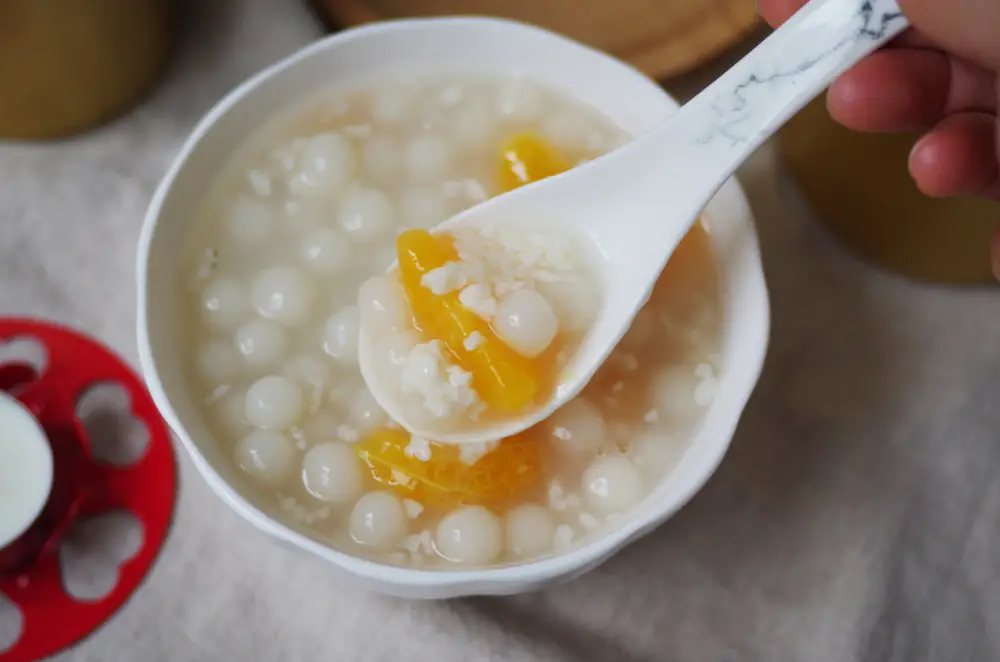Sweet Rice Dumplings in Fermented Rice Wine is a traditional snack originating from the southern regions of China, particularly in Jiangnan. These small, round dumplings are crafted from glutinous rice flour and cooked together with fermented rice wine. The fermented rice wine imparts a rich, sweet, and smooth flavor, while the dumplings offer a soft and chewy texture. This dessert, classified as a sweet treat, primarily consists of ingredients such as glutinous rice and fermented rice wine. It serves as a warm and nourishing food, believed to enhance vitality, strengthen the spleen and stomach, and alleviate excessive sweating.
History of Sweet Rice Dumplings in Fermented Rice Wine
The history of sweet rice dumplings in fermented rice wine can be traced back to the Song Dynasty, originating in Anyang County, which is present-day Anqing City in Anhui Province. In Anyang County, there was a family named An, and they had a poisonous plant called Oleander with a unique fragrance. The elderly lady of the An family, who enjoyed cooking, concocted a method to disguise the toxic odor. She cooked the Oleander with rice wine, added flour, and mixed it into small round dumplings. This marked the birth of sweet rice dumplings in fermented rice wine.
During the Ming and Qing dynasties, sweet rice dumplings became a well-known delicacy in the Jiangnan region. However, due to the intricate production process that required considerable labor and time, it was initially a dish enjoyed by affluent households. As time passed, the crafting of sweet rice dumplings gradually spread to the common people, turning it into a popular and widely consumed food.

In Jiangnan, sweet rice dumplings have become a staple during traditional festivals such as the Spring Festival and Mid-Autumn Festival. Every household prepares these dumplings to pray for family reunion and happiness. People believe that consuming sweet rice dumplings brings good luck and health. As a result, sweet rice dumplings hold a special place in the hearts of the Jiangnan people, becoming an indispensable part of their daily lives.
With the development of time, the production process of sweet rice dumplings has continuously evolved and innovated. While traditional sweet rice dumplings primarily used glutinous rice flour, sweet rice wine, and various nuts and dried fruits, modern variations introduce innovative elements such as fruit juices and chocolate. This diversifies the flavors and aligns with the tastes of contemporary consumers.
Beyond flavor innovations, advancements in production technology have streamlined the crafting of sweet rice dumplings. Traditional methods involved manual rolling, which was time-consuming and labor-intensive. Today, specialized machines have been developed to produce sweet rice dumplings, enhancing efficiency and ensuring consistent shapes and textures.
In addition to these culinary advancements, sweet rice dumplings have become a cultural bridge in international exchanges. More foreigners are becoming familiar with and developing a fondness for this traditional Chinese delicacy. On the global stage, sweet rice dumplings represent a significant symbol of Chinese culinary culture.
How To Make Sweet Rice Dumplings in Fermented Rice Wine
The traditional craftsmanship of making Wine Lees Glutinous Rice Balls, originating from the Jiangnan region, involves unique steps and results in a distinctive texture. Here is a detailed process:
Firstly, prepare the necessary ingredients, including glutinous rice flour, sweet rice wine lees, nuts, and dried fruits. Glutinous rice flour is the main ingredient, and its quality and proportion significantly impact the texture and quality. Sweet rice wine lees are crucial, determining the aroma and sweetness of the balls.
Next, mix glutinous rice flour and water in specific proportions and knead into a dough. Pay attention to water control; too much or too little can affect the texture and shaping. Let the dough rest for a while to allow the glutinous rice flour to absorb water fully, enhancing stickiness and elasticity.
Then, shape the dough into small balls, requiring skill and patience to ensure uniform size and smooth surfaces. After boiling, the balls will float on the water’s surface; scoop them out and immerse them in cold water to cool, preventing sticking.
Following that, place the boiled balls into sweet rice wine lees and stir thoroughly. The amount and sweetness of the lees can be adjusted based on personal preference, and attention should be paid to the temperature, as high temperatures can compromise the aroma and texture.
Finally, add nuts, dried fruits, and other ingredients, stirring again to mix thoroughly before consumption. The types and amounts of additional ingredients can be adjusted according to personal taste, offering different textures and flavors.
In addition to the basic process, some tips can enhance the texture and quality. For instance, applying oil to the hands while shaping the balls prevents sticking, and adding salt to the boiling water improves the smoothness of the balls.
In conclusion, the craftsmanship of making Wine Lees Glutinous Rice Balls is not overly complex, but each step requires skill and attention. Only by mastering these techniques can one create Wine Lees Glutinous Rice Balls with a smooth texture and delightful sweetness.
Moreover, with the evolution of time, the process of making Wine Lees Glutinous Rice Balls has seen continuous innovation. Modern production involves specialized machines for shaping the balls, significantly improving efficiency and quality. Additionally, there are more diverse choices and innovations in the selection of additional ingredients, such as incorporating fruit juice or chocolate, providing a more varied taste experience.
The nutritional value of fermented rice balls
Wine Lees Glutinous Rice Balls, a traditional snack from the Jiangnan region of China, not only boast a unique flavor but also offer rich nutritional value. Glutinous rice flour and sweet rice wine lees are the main ingredients used in making Wine Lees Glutinous Rice Balls, both of which contain abundant nutrients beneficial to the body.

Firstly, glutinous rice flour is a primary ingredient in the preparation of Wine Lees Glutinous Rice Balls. It is rich in carbohydrates, proteins, fats, dietary fiber, and various essential nutrients, providing the body with necessary energy and nutrition. Additionally, glutinous rice flour contains trace elements such as calcium, phosphorus, and iron, which play vital roles in the physiological functions of bones, teeth, and blood.
Secondly, sweet rice wine lees are another crucial component in making Wine Lees Glutinous Rice Balls. Sweet rice wine lees contain a variety of nutrients, including ethanol, sugars, proteins, vitamins, and minerals. Ethanol promotes blood circulation, aids in digestive fluid secretion, and stimulates appetite. Sugars provide the body with essential energy, while proteins and vitamins contribute to maintaining normal physiological functions and supporting growth and development. Furthermore, sweet rice wine lees contain beneficial enzymes and microorganisms such as yeast and lactic acid bacteria, which promote intestinal motility and improve digestive function.
In addition to the nutritional value of glutinous rice flour and sweet rice wine lees, the craftsmanship and choice of ingredients in making Wine Lees Glutinous Rice Balls contribute to their higher nutritional value. The multiple rounds of kneading and boiling during the production process enhance the nutritional content of glutinous rice flour and sweet rice wine lees. The inclusion of various supplementary ingredients also adds nutritional value to the balls. For instance, adding a moderate amount of red dates and wolfberries increases the content of vitamins and minerals in Wine Lees Glutinous Rice Balls. Adding a small amount of osmanthus provides fragrance and antioxidant substances, contributing to overall health.
Apart from the traditional Wine Lees Glutinous Rice Balls made with glutinous rice flour and sweet rice wine lees, modern production techniques have introduced innovative varieties. Some variations incorporate fruit juice or vegetable juice to create different flavors and colors. This innovative approach not only enhances the taste and visual appeal of Wine Lees Glutinous Rice Balls but also provides consumers with more nutritional choices. Additionally, modern producers of Wine Lees Glutinous Rice Balls are increasingly focusing on nutritional ratios and healthy ingredients. By employing scientific formulas and processes, they aim to minimize sugar and fat content while ensuring the delectable taste, enabling consumers to enjoy this culinary delight in a healthier way.
Furthermore, the nutritional value of Wine Lees Glutinous Rice Balls is influenced by how they are consumed. Typically enjoyed as a dessert or snack, they can also be part of breakfast or a late-night snack. When consumed, it is recommended to pair them with a moderate amount of fruits or vegetables to increase dietary fiber and vitamin intake. Additionally, moderation is advised in consumption, as excessive intake may lead to issues such as excessive calorie or sugar intake.
Where is the popularity of fermented rice balls
Wine Lees Glutinous Rice Balls are a longstanding traditional Chinese snack, widely popular in the Yangtze River region, including provinces such as Sichuan, Hunan, and Jiangsu-Zhejiang. In the Jiangsu-Zhejiang region, Wine Lees Glutinous Rice Balls are highly favored as part of breakfast or late-night snacks. Similarly, in Sichuan and Hunan, they are regarded as distinctive local delicacies and are frequently found in local restaurants and night markets.

The popularity of Wine Lees Glutinous Rice Balls is attributed not only to their unique flavor and rich nutritional content but also to the meticulous craftsmanship and selection of ingredients. The combination of glutinous rice flour and sweet rice wine lees provides a variety of nutrients, including carbohydrates, proteins, vitamins, and minerals, meeting the nutritional needs of the body. The inclusion of supplementary ingredients enhances the taste and nutritional value of Wine Lees Glutinous Rice Balls. For example, adding red dates, wolfberries, and other ingredients increases the content of vitamins and minerals. Additionally, the incorporation of osmanthus provides fragrance and antioxidant properties, contributing to overall health.
As Chinese culinary culture spreads and exchanges globally, Wine Lees Glutinous Rice Balls have gradually gained popularity beyond China’s borders, becoming a beloved delicacy among international enthusiasts. In cosmopolitan cities like Beijing and Shanghai, an increasing number of restaurants and cafes are offering this traditional snack, attracting many foreign customers eager to savor its unique taste.
In conclusion, Wine Lees Glutinous Rice Balls are widely popular in the Yangtze River region of China and internationalized cities, representing a nutritious and uniquely flavored culinary delight.
Conclusion
In summary, Wine Lees Glutinous Rice Balls, as a representative of traditional Chinese cuisine, carry a rich history and cultural significance. The crafting techniques and ingredients have evolved and innovated with the passage of time. Looking forward, we hope that this traditional delicacy will continue to receive protection and inheritance, while also expanding and flourishing through innovation, becoming a beloved culinary delight for both Chinese and international enthusiasts.
